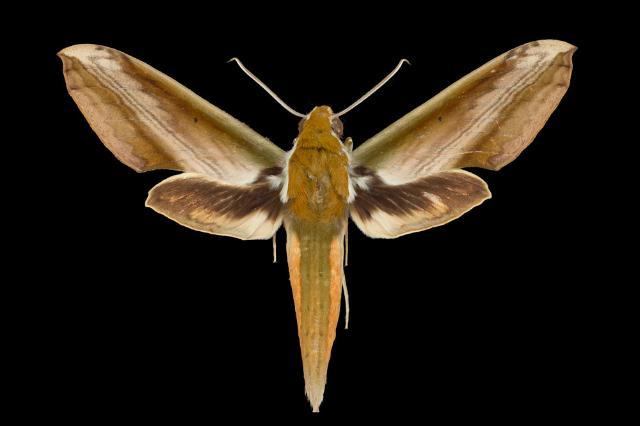Study reveals evolutionary history of hawkmoths’ sonar jamming defense
May 4, 2015

Hawkmoths, including this species belonging to the subtribe choerocampine, produce ultrasound as a defense against bats. A new University of Florida study found that many species have used a sound-producing system found in their genitals to elude bats for millennia. Florida Museum of Natural History photo by Pablo Padron.
In the 65-million-year-old arms race between bats and moths, some moth species rub their genitals to jam the calls of bats. Radar jamming is commonly used in human warfare, allowing pilots to render themselves invisible. By unraveling the evolution of hawkmoths’ similar defense, authors of a new study appearing online this week in the Proceedings of the National Academy of Sciences aim to better understand nocturnal biodiversity and improve human uses of sonar.
Study researchers with the University of Florida and Boise State University tracked sonar jamming throughout the evolutionary history of hawkmoths and found that one of the insect world’s most sophisticated defense mechanisms is more widespread than originally thought, existing for millennia.
Until now, the function and evolution of sonar jamming remained largely a mystery, said lead author Akito Kawahara, assistant curator of Lepidoptera at the Florida Museum of Natural History on the UF campus.
“Before now people thought ultrasound usage in insects was very restricted to certain groups, but it looks much more complex than that,” Kawahara said.
Kawahara and collaborators scoured jungles and forests from Borneo to the Amazon observing hawkmoths. They collected specimens at 70 sites in 32 countries and conducted field-based echolocation experiments and lab experiments using more than 700 moths. After testing the response of 124 species of hawkmoths, researchers found nearly half generated ultrasonic sounds with their genitalia.
Researchers also built an evolutionary tree for hawkmoths based on the fossil record, which revealed that the first ultrasound-producing hawkmoths arose in the late Oligocene period about 26 million years ago. Their ability to produce ultrasound arose soon after the origin of tiger moths, originally thought to be the only major moth group to use sonar against bats, Kawahara said. Tiger moths produce ultrasonic sound using tymbals, a vibrating membrane located on the thorax, rather than their genitals.
“Our evolutionary tree demonstrates that sonar jamming and the ability to hear bat attack calls evolved twice during the Miocene after the radiation of insectivorous bats,” Kawahara said.
Kawahara’s team from the Florida Museum’s McGuire Center for Lepidoptera and Biodiversity worked with Jesse Barber, an assistant professor with the department of biology at Boise State University, and his research group to pit big brown bats against hawkmoths in field and lab experiments that tested the function of hawkmoth antibat ultrasound. In one experiment, study researchers played pre-recorded bat attack calls to study how moths responded.
The study shows in these experiments, moths’ acoustic defense was immediately and consistently effective, while bats that failed to capture sound-producing hawkmoths often performed catching behavior without subduing prey.
Researchers said the evolution and maintenance of ultrasound production in these groups might be driven by response to predators other than only bats, such as ultrasonically sensitive rodents, shrews and primates.
“This is just the beginning – we are trying to chip away at what goes on with nocturnal insect biodiversity,” Kawahara said.
